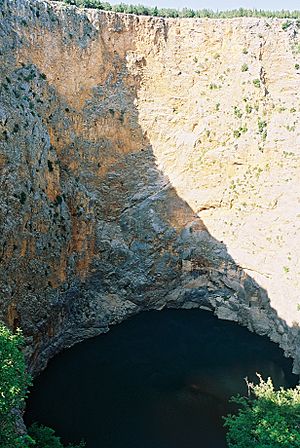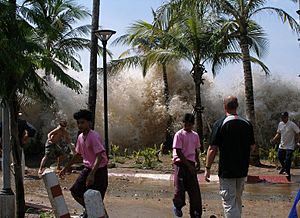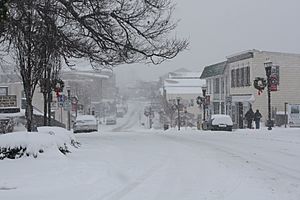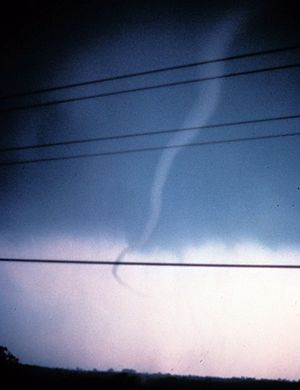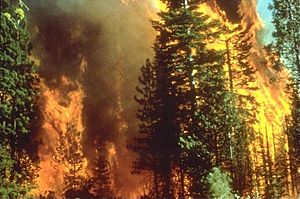Natural disaster facts for kids
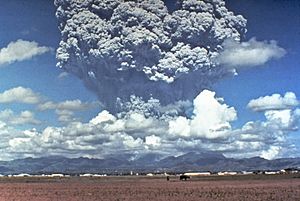
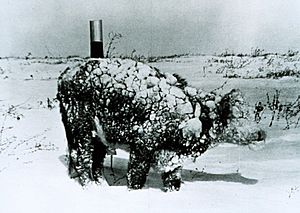
A natural disaster is a big event caused by Earth's natural processes. Think of things like floods, hurricanes, tornadoes, volcanic eruptions, earthquakes, and tsunamis. These events can cause harm to people, damage homes and buildings, and affect the economy.
What makes an event a "disaster" is the harm it causes to people and their property. If a strong earthquake happens where no one lives, it's usually not called a disaster because it doesn't affect people.
The International Red Cross and Red Crescent Movement was created to help people during emergencies, including natural disasters. Rules from international law also help guide how people should be protected during these times.
Contents
Geological Disasters
Geological disasters are natural events that happen because of processes deep within the Earth or on its surface.
Avalanches and Landslides
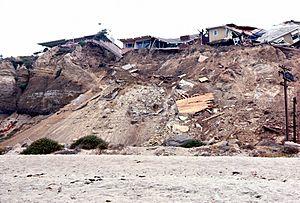
A landslide happens when a lot of rock, soil, or other material on a slope suddenly moves downward and outward. It's like a giant slide of earth.
Avalanches are similar, but they involve large amounts of snow and ice sliding down a mountain. During World War I, between 40,000 and 80,000 soldiers died from avalanches in the Alps mountains. Many of these avalanches were started by artillery fire.
Earthquakes
An earthquake happens when there's a sudden release of energy in the Earth's crust. This energy creates seismic waves that make the ground shake and vibrate. Earthquakes are caused by parts of the Earth's crust slipping along cracks called faults.
The spot deep underground where an earthquake starts is called the seismic focus. The point directly above it on the surface is called the epicenter. Earthquakes themselves rarely kill people. Instead, it's the things they cause, like buildings collapsing, fires, or tsunamis (giant sea waves), that are dangerous. Better building designs and early warning systems can help save lives.
Sinkholes
A sinkhole forms when the ground becomes too weak to support what's on top of it and collapses. This can happen because of natural erosion, human mining, or underground digging. For example, the 2010 Guatemala City sinkhole formed when heavy rain from a storm washed away soft rock underground, causing the surface to suddenly collapse.
Volcanic Eruptions
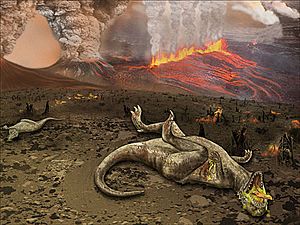
Volcanoes can cause a lot of damage in several ways. The eruption itself can be dangerous with explosions and falling rocks. Lava flowing from the volcano is extremely hot and destroys everything in its path.
Volcanic ash, which is cooled ash, can form a thick cloud and settle on nearby areas. If there's enough ash, it can make roofs collapse. Breathing in ash is also harmful because it's like tiny pieces of glass. The most dangerous part of a volcanic eruption is often the pyroclastic flows. These are fast-moving clouds of hot ash and gas that rush down the volcano's slopes. It's believed that the ancient city of Pompeii was destroyed by a pyroclastic flow.
A lahar is a volcanic mudflow or landslide. The 1985 Armero tragedy in Colombia was caused by a lahar, burying the town of Armero and killing about 23,000 people.
Very powerful volcanoes, called supervolcanoes, are rated 8 on the Volcanic Explosivity Index. The main danger from a supervolcano is the huge cloud of ash it releases. This ash can have a terrible global effect on climate and temperatures for many years.
Hydrological Disasters
Hydrological disasters involve violent and sudden changes in Earth's water, whether it's in lakes, rivers, or the atmosphere.
Floods

A flood happens when water overflows and covers land that is usually dry. This can happen when a river or lake gets too full and its water spills out of its normal boundaries. It's considered a significant flood when the water covers areas used by people, like villages, cities, roads, or farms.
Tsunamis
A tsunami (pronounced "soo-NAH-mee") is a series of giant waves in a body of water, usually an ocean or a large lake. These waves are caused by a large amount of water being suddenly moved. This can happen because of undersea earthquakes, like the 2004 Boxing Day tsunami, or by landslides, or volcanic eruptions. On March 11, 2011, a tsunami hit near Fukushima, Japan, and spread across the Pacific Ocean.
Limnic Eruptions
A limnic eruption is a rare event where a gas, usually carbon dioxide (CO2), suddenly bursts out from deep lake water. This gas can suffocate animals and people nearby. Such an eruption can also cause tsunamis in the lake as the rising gas pushes the water. Scientists believe landslides, volcanic activity, or explosions can trigger these eruptions. Only two limnic eruptions have been recorded. In 1986, a large eruption at Lake Nyos in Cameroon killed between 1,700 and 1,800 people by suffocation.
Meteorological Disasters
Meteorological disasters are natural events caused by extreme weather conditions.
Cyclonic Storms
Cyclones, tropical cyclones, hurricanes, and typhoons are all names for the same type of powerful storm system that forms over oceans. The name depends on where the storm starts. In the Atlantic Ocean, they are called "hurricanes." In the Northwest Pacific, they are called "typhoons." In the South Pacific and Indian Ocean, they are called "cyclones."
The deadliest hurricane ever was the 1970 Bhola cyclone in Bangladesh. Another famous hurricane was Hurricane Katrina, which caused huge damage in the United States in 2005.
Blizzards
Blizzards are severe winter storms with heavy snow and strong winds. If strong winds pick up snow that has already fallen, it's called a ground blizzard. Blizzards can stop daily activities and cause economic problems, especially in places where heavy snow is unusual. The Great Blizzard of 1888 in the United States destroyed many wheat crops.
Hailstorms
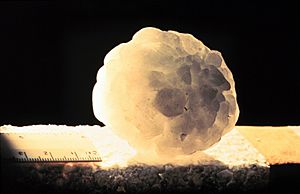
Hailstorms happen when ice falls from the sky and doesn't melt before hitting the ground. Hailstones can be small, like peas, or as large as grapefruits. A very damaging hailstorm hit Munich, Germany, in 1984, causing about $2 billion in insurance claims.
Ice Storms
An ice storm is a type of winter storm where freezing rain falls and creates a layer of ice on surfaces. The U.S. National Weather Service says an ice storm happens when at least 0.25 inches (6.4 mm) of ice builds up on exposed surfaces. This ice can make roads very slippery and cause power lines to break.
Cold Waves
A cold wave is a period of unusually cold weather. The U.S. National Weather Service defines it as a quick drop in temperature over 24 hours that requires extra protection for farming, businesses, and people. The exact temperature drop depends on the region and time of year.
Heat Waves
A heat wave is a period of unusually and extremely hot weather. The 2003 European heat wave was one of the worst in recent history. In 2009, a summer heat wave in Victoria, Australia, created conditions that led to massive bushfires. Melbourne had three days in a row with temperatures over 40 °C (104 °F). The 2010 Northern Hemisphere summer also had severe heat waves, which killed over 2,000 people and caused many wildfires.
Droughts
A drought is when the soil becomes unusually dry because there has been much less rainfall than average for a long time. Hot, dry winds and high temperatures can also make droughts worse by evaporating moisture from the ground. Droughts often lead to crop failures and water shortages.
The Millennium Drought in Australia from 1997 to 2009 caused a major water supply crisis. As a result, many desalination plants were built to turn saltwater into fresh water.
Thunderstorms
Thunderstorms can create lightning. Besides the usual storm damage from winds, hail, and flooding, lightning itself can damage buildings, start fires, and even kill people or animals directly. Many lightning deaths happen in poorer countries where lightning is common and homes offer little protection.
Tornadoes
A tornado is a powerful, spinning column of air that touches both the Earth's surface and a cloud. It's also called a twister. Tornadoes come in many shapes and sizes, but they often look like a visible funnel cloud that touches the ground and is surrounded by dust and debris.
Most tornadoes have wind speeds less than 110 mph (177 km/h) and are about 250 ft (76 m) wide. They usually travel a few miles before disappearing. The most extreme tornadoes can have wind speeds over 300 mph (480 km/h), stretch more than two miles (3 km) across, and stay on the ground for dozens of miles.
Wildfires
Wildfires are large fires that often start in wild areas. Common causes include lightning and drought, but wildfires can also be started by human carelessness or arson. They can spread to populated areas, threatening people, homes, and wildlife. The Peshtigo Fire in the United States in 1871 killed at least 1,700 people.
Space Disasters
These are natural events that happen because of things in space.
Impact Events and Airbursts

When asteroids hit Earth, they can cause huge extinction events. One such event created the Chicxulub crater 64.9 million years ago and is linked to the disappearance of the dinosaurs.
Even asteroids and comets that burn up in the atmosphere can cause major damage on the ground due to an air burst explosion. The Tunguska event in June 1908, for example, flattened a large area of forest in Siberia. The Chelyabinsk meteor on February 15, 2013, caused widespread property damage and injured many people in the city of Chelyabinsk, Russia.
Solar Flares
A solar flare is when the Sun suddenly releases a huge amount of solar radiation, much more than usual. Solar flares are unlikely to directly harm people on Earth, but they can damage electrical equipment and power grids. The 1859 Carrington event was a powerful solar storm that disrupted telegraph networks. The March 1989 geomagnetic storm caused a power blackout in Quebec, Canada.
Images for kids
-
1755 drawing showing Lisbon in ruins after the 1755 Lisbon earthquake. A tsunami is also shown overwhelming ships in the harbor.
-
A wildfire in California.
See also
 In Spanish: Desastre natural para niños
In Spanish: Desastre natural para niños


